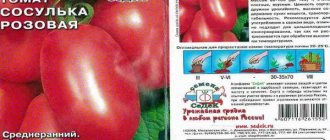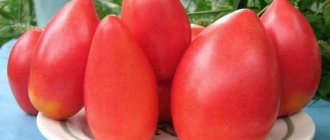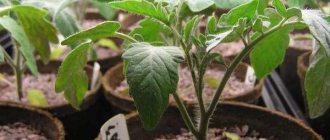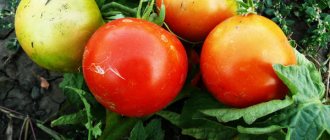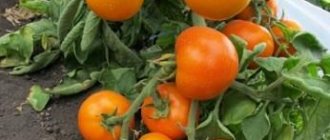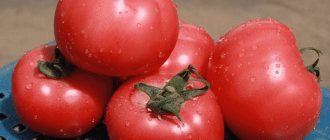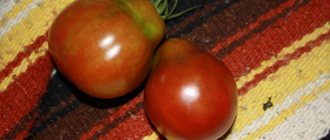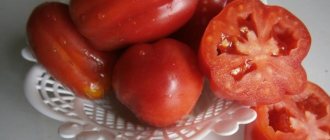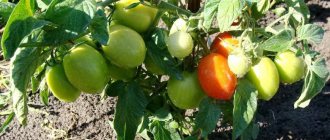Description of the tomato variety Pink Pear with photo
Vegetable growers are always attracted to varieties that have some unique characteristic. For example, pink pear-shaped tomatoes are very popular among lovers of original shapes. These tomatoes have a corresponding name - Pink Pear. The hybrid was bred by Siberian scientists by selecting seeds. The Pink Giant tomato was chosen for the work.
An external description of the plant will help you get to know the Pink Pear variety better and in more detail:
- Bush of indeterminate type. Such tomatoes are not limited in growth. They consistently form clusters, so their fruiting period is extended. The first cluster of the Pink Pear variety is tied above the 8-9 leaf. The next ones are three sheets apart. With good care, the bush produces more than 12 brushes. Experienced gardeners recommend leaving no more than 7-8 brushes. The height of an adult plant reaches 160 cm (open ground) and 200 cm (greenhouse). Important! A tomato variety with these parameters requires tying and shaping.
- The stem is not very powerful. Foliage and shoot formation are moderate, internodes are long.
- The leaves are tomato-type, green, slightly corrugated, ribbed, with long petioles. The leaf structure allows the variety to resist pests well.
The originator established a greenhouse method of cultivation. However, vegetable growers in the southern regions get a good tomato harvest in open ground.
In addition to the description, a photo of the Pink Pear tomato variety:
With proper care, tomato bushes are completely covered with delicious fruits.
Description of fruits
Pink pear is an extraordinary tomato. In addition to nutritional value, the fruits of the variety have other attractive characteristics. For example, the high decorative effect that the form provides. Basic parameters of Pink Pear tomatoes:
- The shape is elongated, slightly ribbed, reminiscent of a pear.
- The weight is small, the average value is about 100 g (greenhouse) and 75 g (open ground).
- The color is deep pink, with a slight pearlescent tint. Unripe fruits are light green, with a dark spot near the stalk. When the tomato ripens, the stain disappears.
- The skin is strong, medium density, glossy.
- The pulp is juicy and fleshy. The number of seed chambers is no more than two.
- The taste is tomato, the combination of sweet and sour is well balanced.
The fruits ripen in clusters, each consisting of 5-7 tomatoes.
Uniform coloring of fruits is the result of compliance with agricultural technology requirements
Tomatoes Pink pears
Siberian variant
Description of the Orange Pear variety may be of interest to lovers of yellow and orange tomatoes. Ideally smooth fruits have a wonderful taste. You can make a delicious salad from them or use them for preparations. The size of the tomatoes is smaller than average - tomatoes weigh from 50 to 80 g.
Pink fruits, similar to small pears, weigh no more than 80 g in open ground and about 90 g when growing tomatoes in a greenhouse. The purpose of pink tomatoes is universal. The variety has a slight drawback - the skin of overripe fruits may crack. Summer residents who decide to choose this variety will like the taste of the fruit and their appearance: color, shape, size.
From the varieties offered, you can easily choose an interesting type of tomato. Anyone who has already planted pear-shaped varieties this season can share their results.
Characteristics of the pink pear tomato
The list of characteristics of a variety is very important for farmers. It gives a complete picture of the expected result. The most significant parameters are considered:
- Transportability and keeping quality. Both qualities are excellent due to the dense skin of the fruit. The Pink Pear tomato tolerates transportation and storage very well, while completely retaining its taste and presentation.
- Tomatoes do not crack when ripe.
- The variety has good adaptability to changes in weather conditions.
- High percentage of seed germination. The value is at least 80%-90%.
- Resistance to major crop diseases.
In addition to the listed characteristics, the Pink Pear tomato variety is valued for its productivity and wide range of uses.
Pink pear tomato productivity and fruiting
The variety belongs to medium-ripening tomatoes. The first harvest can be harvested 110-120 days after emergence. This figure may vary slightly due to the climatic conditions of the region. The productivity of Pink pear on open ridges is about 3 kg per bush. From an area of 1 sq. m you can collect from 6.0 kg to 6.7 kg of tasty fruits. When grown in greenhouses, the yield is 9-10 kg. Productivity increases when the bush is formed into one stem and timely pinching. The second condition is for 1 sq. m should grow no more than four plants.
The yield indicator makes it possible to grow the Pink Pear variety on an industrial scale
Area of application of fruits
Tomato variety Pink Pear for universal use. They are very good fresh. When added to salads, they not only improve the taste of the dish, but also decorate it perfectly. Due to their low weight, they are used for whole-fruit canning. Pear-shaped tomatoes produce rich juices, excellent vegetable preparations, and spicy adjika.
The fruits of the Pink Pear are extremely tasty even without cutting.
Resistance to diseases and pests
According to the description and reviews of vegetable growers, the Pink Pear variety exhibits good resistance to the main diseases and pests of nightshades. However, this characteristic may differ in regions with different climates. For example, growing outdoors in an area with cold, rainy and short summers will result in late blight.
Characteristics and description of the tomato variety
The variety was bred through high-quality selection of Pink Giant tomato seeds. In regions with cool climates, pears are grown in greenhouse conditions . In the southern regions of the country, tomato is cultivated in open ground.
The bush reaches a height of 1.3 m, but in greenhouse conditions the crop grows up to 1.7 m . From the moment of planting to the harvest of the first harvest, 105-115 days pass. The variety shows good yield if the pear is formed into one stem. The plant needs pinching and tying the bush to a support.
Distinctive characteristics of the fruit
Dense, fleshy tomatoes have a smooth shell . The shape of the fruit resembles a pear. The color of the vegetables is deep pink. When growing the variety in open ground, the weight of one tomato reaches 50 g, in greenhouse conditions - up to 75 g. Up to 11 kg of crop is harvested from one square meter if there are no more than 4 bushes on it.
The variety is universal in use . Tomatoes are used to make juice, sauce, and adjika. Tomatoes are also great for winter preparations.
On a note. Due to their excellent taste and good presentation, tomatoes are successfully sold in markets and grocery stores.
Advantages and disadvantages
In addition to its extraordinary name, the Pink Pear variety has remarkable characteristics. They fully correspond to the description and are confirmed by reviews of vegetable growers.
Timely loosening of the soil and removal of the lower leaves will prevent tomatoes from cracking near the stalk
pros
- uniformity of fruit mass;
- originality of the shape of tomatoes;
- versatility of use;
- resistance to nightshade diseases;
- good taste;
- high and stable yield;
- ability to bear fruit in open ground;
- good transportability and keeping quality.
Minuses
- the need to garter the bush;
- in dry times, roots may crack due to lack of moisture;
- the plant needs to be planted in a timely manner;
- sensitivity to lighting and ambient temperature;
- the variety’s tendency to certain diseases depending on the growing region.
Pros and cons of the variety
The Pink Pear variety has a number of positive characteristics :
- excellent taste;
- versatility in application;
- original appearance;
- good transportability;
- high productivity;
- the same size and weight of the fruit;
- strong immunity to diseases.
Disadvantages of the variety:
- the bush must be constantly tied up;
- culture needs stepsoning;
- roots crack if there is insufficient moisture.
Other varieties of pink tomatoes:
A bright and tasty decoration for your site - “Monisto pink”
Tips for growing Pink Heart tomatoes
The popular tomato variety “Sugar Nastasya”
Features of cultivation
The mid-season hybrid is grown in seedlings. To get high-quality seedlings, the gardener needs to perform several steps sequentially:
- Purchase and prepare planting material. You need to buy seeds in a specialized store. A hybrid grown from seeds collected by oneself will not have all the varietal characteristics. The next step is to treat the seeds with a weak solution of potassium permanganate for 20 minutes. Some gardeners also use the preparations Virtan-Micro or Potassium Humate, which improve germination.
- Prepare soil and containers for seedlings. There are two options - purchase a ready-made soil mixture for vegetable seedlings or make it yourself. In the second case, you need to mix turf soil, peat and humus in equal proportions. It is better to take a container of a size that easily fits on the windowsill.
- Meet the deadline. It is recommended to start sowing seeds for planting seedlings in greenhouses in early March. For open ground - at the end of the same month.
The sowing process is standard. Fill the containers with soil and lightly water them. Place the seeds in the furrows to a depth of 1.5-2.0 cm, cover with a thin layer of soil. Moisten the surface with a spray bottle, cover with glass or film, and place in a warm place.
Ventilate the greenhouse periodically, moisten the soil and remove condensation. Shoots of the Pink Pear variety appear in 7-8 days, and after another week, leaves form on the seedlings. Pick seedlings when two true leaves appear. You can transplant tomato seedlings into separate cups or into one larger box. In this case, you need to leave a distance of 10x10 cm between neighboring plants. At the time of picking, deepen the seedlings of the Pink Pear variety to the cotyledon leaves. Indeterminate tomatoes need a second picking, which is recommended 14 days after the first. Now each bush needs a separate container with a volume of at least 1 liter.
During the period of growing Pink Pear tomato seedlings, two feedings should be carried out, preferably with Nitroammophoska.
Be sure to regulate watering. Make sure that there is no crust on the surface of the soil, but the plants also do not need excess moisture.
Two weeks before transplanting to a permanent location, Pink Pear seedlings need to begin hardening off.
Healthy tomato seedlings take root very quickly
Disembarkation times:
- unheated greenhouse – May;
- open ridges – June.
The planting pattern is 40x50 cm. The beds should be well lit. Caring for the variety consists of several points:
- Watering. Regular, but dosed. The water should be settled and moisturized at the root.
- Loosening and weeding. It is important to proceed carefully so as not to damage the roots and only after watering.
- Stepsonning. Mandatory procedure for Indians. Form into 1-2 stems.
- Feeding - once every three weeks. Be sure to alternate mineral compositions and organic matter.
Important! Application of manure should be avoided.
Growing seedlings
The tomato variety Pink Pear requires effort on the part of gardeners when planting seeds. First of all, the seeds are heated, then treated with a manganese solution and waited for about half an hour. The solution is prepared as follows: in 1 tbsp. About 3 g of potassium permanganate should be added to clean water, wrapped with a rag and left in this position for germination.
Landing in the ground
Germinating seeds are planted in the ground. They collect soil into a box and plant it in it. It is recommended to do this at a depth of 2 cm from the surface. Each hole is watered with warm water, after which the box is placed in a place with a high level of illumination.
As soon as the first leaves appear, the tomato variety is planted in open ground. It is ideal to combine the landing process with picking. If the greenhouse is heated, seedlings are planted in it in early May. If there is no heating, planting is carried out at the beginning of summer.
This variety of tomatoes requires good ventilation of the seedlings, so several important rules must be taken into account: loosen the soil as often as possible, remove the lower leaves from the plant so that more air can reach the roots.
Pest and disease control
Problems with the variety arise for several reasons. For example, white rot is the result of a deficiency of potassium and magnesium in the soil. This disease is also transmitted to tomato beds from other vegetable crops. Control methods include removing rotten shoots or the entire bush. To prevent the spread of fungal and viral diseases, it is necessary to disinfect the seeds in a solution of potassium permanganate. Then, at the beginning of growth, the tomatoes need to be watered with the same mixture.
To combat the Colorado potato beetle, it is better to use chemical agents (Killer, Bankol, Karate). Hand picking can only be practiced in small planting areas. Copper sulfate or wood ash work well against slugs and caterpillars. To ward off pests, it is enough to dust the roots of Pink Pear tomatoes.
Growing tomatoes
Pink Pear tomatoes should be grown in seedlings.
How to prepare seeds?
Before planting, select whole and dense seeds. Planting material requires heating and subsequent processing. To do this, the seeds are placed in a manganese solution for 20-25 minutes.
For better germination, seeds are treated with Virtan-Micro or potassium humate. Germinate the seeds in damp gauze.
Sowing seed material
Sprouted planting material is sown in a container with light soil to a depth of 18-25 mm and sprayed with warm water. Boxes with future seedlings are placed on a well-lit windowsill, heated balcony or glassed-in terrace.
After several true leaves appear on the plants, picking is carried out in separate pots.
Rules for planting seedlings
Seedlings are planted in heated greenhouses at the end of April. Tomatoes can be transferred to unheated film and glass shelters no earlier than the second ten days of May, at the age of two months.
Experts advise placing it on 1 sq. meter no more than 4 tomato bushes.
Agricultural technology
The variety is grown using the popular seedling method. Sowing seeds for seedlings is carried out 60 - 65 days before the intended transplantation into the ground. Based on this, in each region it is advisable to independently calculate the sowing time. In the southern regions, this process can begin in mid-February, in cool regions - almost a month later, in March. Tomatoes are planted in a greenhouse at the end of April, in open ground - in May or June. The seeds are processed in the usual way, the depth of embedding in the soil is 2 - 3 cm. Picking is carried out after the appearance of the second true leaf. 10–15 days before transplanting to a permanent place, the seedlings begin to harden. Given the tallness of the plant, it is impossible to do without a garter. The culture shows the best performance when formed into 2 stems. To do this, leave one stepson located under the first flower brush, the rest are removed. In order for the entire crop to ripen, no more than 6–8 fruit clusters are left on the bush. The top is pinched to limit further growth. Plant care is carried out as standard. Watering is carried out as needed. To moisturize, it is recommended to use water heated in the sun. Fertilizing is carried out with complex mineral fertilizers. Tomatoes are planted regularly. Preventive measures will protect the red pear from possible diseases and pests. Loosening will restore air exchange in the soil, and weeding will get rid of weeds competing for food and moisture.
The place for planting this variety should be sunny, the soil should be nutritious and loose. When growing in a greenhouse, it is advisable to protect the plant from drafts. The planting pattern is traditional - 40 cm between bushes, row spacing - 50 cm. Recommended density per 1 square meter - 3 plants, formed into two stems, or 4, formed into one trunk.
This variety is valued for the original appearance of the fruit, productivity, good taste and excellent opportunities for whole-fruit canning. The downside is the need for gartering and shaping.
Features of agricultural technology
- Keeping a bush with no more than 3 stems, 2 is better. It is important to remove excess shoots on time.
- To obtain medium-sized tomatoes, 8 brushes are enough.
- Watering should be regular and moderate. If you allow too much, the tomatoes will burst at the stem. The best time to moisten is in the evening, so that the sun's rays do not burn the leaves. Root watering is recommended.
- The seedling period is required; sowing should begin in the first half of March.
- Late blight is dangerous for plants. Prevention includes frequent ventilation and treatment with special compounds. A copper solution works well.
- The pear-shaped tomato is not ready to be crowded, so you should not plant more than 4 bushes per m². A distance of 60 cm will provide a convenient approach to each bush and will not create a greenhouse effect.
- Particular attention should be paid to the prevention of rot, fungus and pest control. Spraying with solutions such as Fundazol or Ordan helps.
Advice. In order for tomato ventilation to be more effective, it is necessary to remove the lower rows of leaves from the bushes.
Pink pear is suitable for private cultivation and industrial cultivation. Harvesting is simplified by cluster fruiting and uniform ripening. The combination of the original shape and good taste of the tomato attracts gardeners. Can be grown in both warm and cold weather conditions.
Agricultural technology
The method of formation and agricultural technology are completely identical to its red predecessor. But once again I would like to note that the planting site and care play a big role in the yield and taste. Plants should receive the maximum amount of sunlight, then the taste of the fruits will be sweet, and not watery and insipid.
This variety is valued for its high yield, good taste, original fruit shape and color. Although there are isolated negative statements regarding the taste, and the color in the rolls does not look very advantageous. In addition, the plant requires garter and shaping.
In addition to the varieties listed above, there are others with similar names:
- Orange pear. A mid-ripening indeterminate variety that begins to ripen 110–115 days after germination. The shape of the fruit is pear-shaped, the color is orange, the tomatoes are quite dense. The fruits are small - 45 - 65 grams. The pulp is fleshy, the taste is good. Productivity – 5.0 – 5.6 kg per 1 square meter.
- Siberian pink pear. The plant is semi-determinate, early ripening (98 – 110 days after the appearance of seedlings). The fruits are smooth, pear-shaped, small - 30 - 50 grams. Pink colour. Each cluster produces 5–7 fleshy fruits.
- Giant pear. Indeterminate, mid-ripening variety - the beginning of ripening occurs 100 - 115 days after emergence. The tomatoes are cuboid-pear-shaped, ribbed, dense. When ripe they turn red. The average fruit weight is 200 – 300 grams. The pulp is juicy and fleshy. Productivity 8 – 9 kg per 1 square meter.
